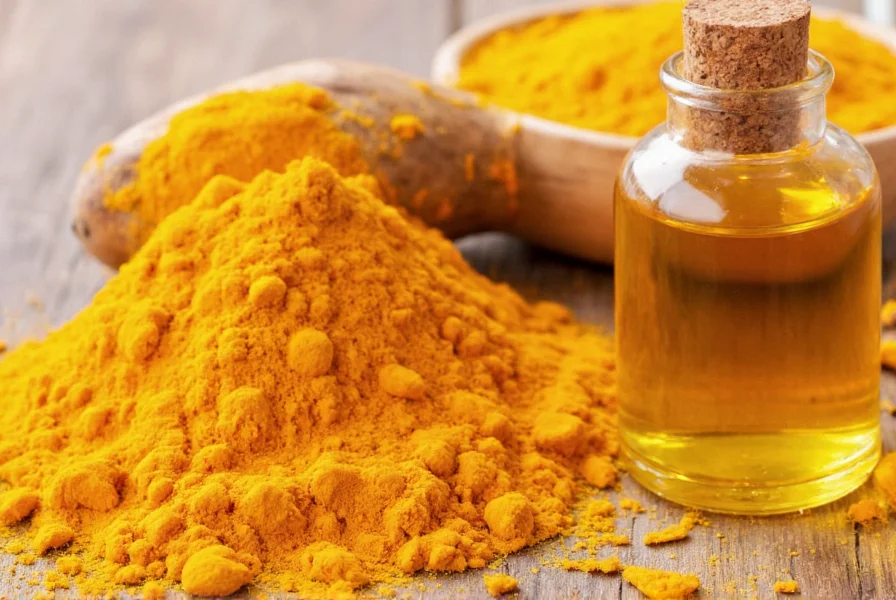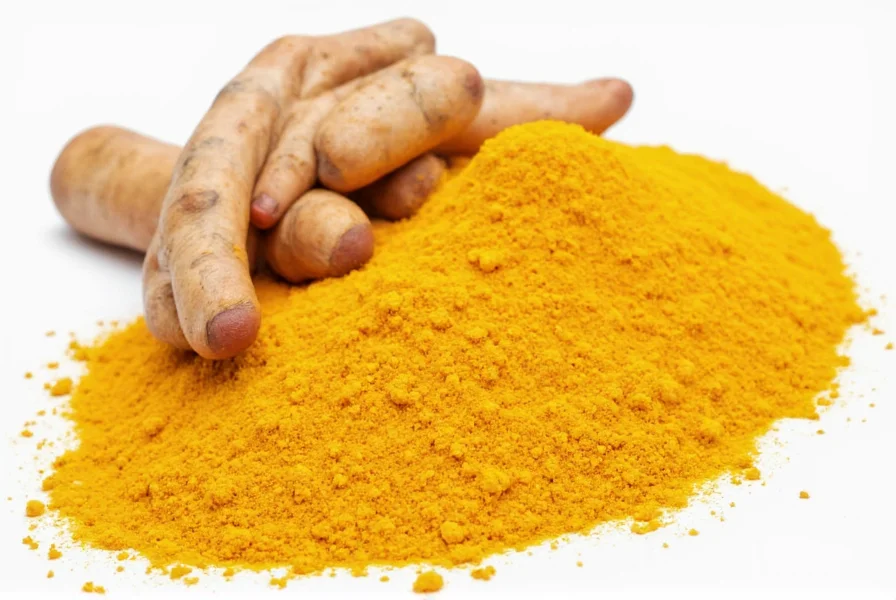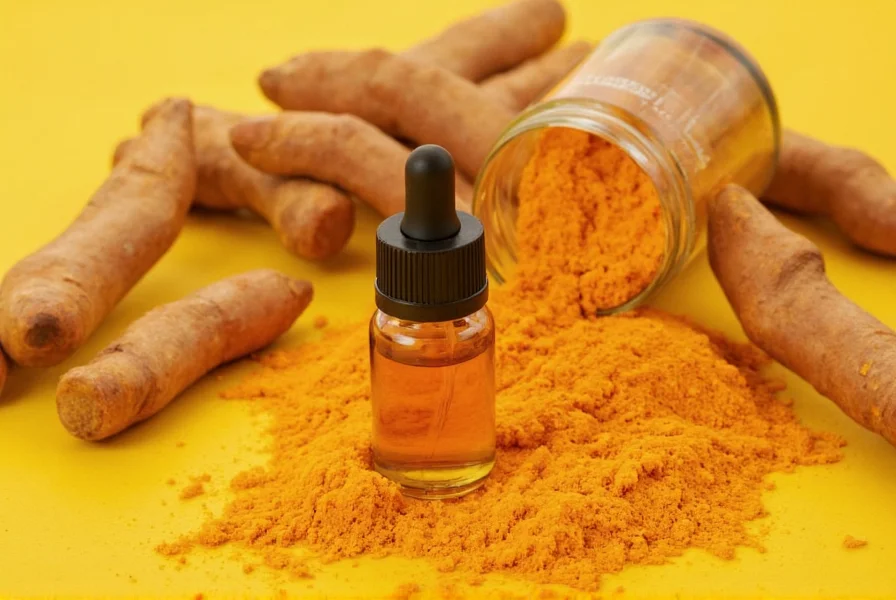Turmeric oil represents a specialized derivative of the well-known turmeric plant, offering distinct properties from its more common powdered counterpart. While turmeric powder contains curcuminoids (primarily curcumin) responsible for many health benefits, turmeric oil contains different volatile compounds that provide unique therapeutic properties. Understanding these differences is crucial for anyone considering incorporating turmeric oil into their wellness routine.
What Exactly Is Turmeric Oil?
Turmeric oil is an essential oil obtained through steam distillation or supercritical CO2 extraction of turmeric rhizomes (roots). This process captures the volatile aromatic compounds while leaving behind the non-volatile curcuminoids. The primary bioactive components in turmeric oil include:
- ar-Turmerone (typically 25-40%)
- α-Turmerone
- β-Turmerone
- Zingiberene
- α-Phellandrene
These compounds give turmeric oil its distinctive earthy, spicy aroma and different therapeutic properties compared to curcumin-based products. The extraction method significantly impacts the oil's composition and quality, with CO2 extraction generally preserving more of the delicate compounds than traditional steam distillation.

Turmeric Oil vs. Other Turmeric Products
Many consumers confuse different turmeric preparations. Understanding these distinctions is essential for proper usage:
| Product Type | Primary Compounds | Best Uses | Bioavailability |
|---|---|---|---|
| Turmeric Powder | Curcuminoids (2-8% curcumin) | Culinary use, basic supplementation | Low (enhanced with black pepper) |
| Curcumin Supplements | Standardized curcumin (95%) | Systemic health benefits | Moderate to high (with enhancers) |
| Turmeric Essential Oil | ar-Turmerone, turmerones | Aromatherapy, topical applications | High for topical use, not for ingestion |
This comparison of turmeric oil benefits versus powder highlights why these products shouldn't be used interchangeably. Turmeric oil for skin applications works through different mechanisms than ingested curcumin supplements. The question of turmeric oil vs curcumin isn't about which is better, but which is appropriate for specific needs.
Scientifically Supported Benefits of Turmeric Oil
Research on turmeric oil, while less extensive than on curcumin, shows promising results in several areas:
Anti-inflammatory Properties
Studies indicate that ar-turmerone in turmeric oil may help reduce inflammation through different pathways than curcumin. A 2020 study published in Phytotherapy Research demonstrated that topical application of diluted turmeric oil reduced inflammatory markers in skin models. This supports the traditional use of turmeric oil for joint discomfort when properly diluted.
Skin Health Applications
One of the most well-documented uses of turmeric oil is for skin health. Research suggests potential benefits for:
- Supporting healthy skin barrier function
- Promoting balanced skin tone
- Maintaining clear skin when used in proper dilution
- Supporting skin's natural healing processes
When exploring turmeric oil benefits for skin, it's important to note that pure essential oils should never be applied directly to skin. The proper method for using turmeric oil topically involves dilution with carrier oils like coconut or jojoba oil at concentrations of 1-2%.
Safe Usage Guidelines for Turmeric Oil
Understanding how to use turmeric oil safely is critical for positive experiences. Unlike some other essential oils, turmeric oil has specific considerations:
Proper Dilution Techniques
For topical applications, always dilute turmeric oil:
- For general use: 1-2% dilution (5-10 drops per ounce of carrier oil)
- For sensitive skin: 0.5-1% dilution (2-5 drops per ounce)
- Never apply undiluted to skin
Aromatherapy Applications
For inhalation benefits of turmeric oil:
- Add 3-5 drops to a diffuser with water
- Perform a patch test before extensive use
- Limited to 30-60 minute sessions
Important Safety Considerations
Turmeric oil safety precautions include:
- Not for internal consumption unless under professional guidance
- May cause skin staining (yellow-orange color)
- Potential photosensitivity - avoid sun exposure after application
- Not recommended for pregnant or breastfeeding women without medical consultation
- Keep away from eyes and mucous membranes

Evaluating Quality in Turmeric Oil Products
When selecting turmeric oil, consider these quality indicators:
- Botanical name: Must specify Curcuma longa
- Extraction method: Steam distilled or CO2 extracted
- Chemotype: Look for ar-turmerone content (25-40%)
- Purity statement: Should be 100% pure essential oil without additives
- GC/MS report: Reputable suppliers provide gas chromatography reports
Be cautious of products labeled as "turmeric oil" that are actually turmeric-infused carrier oils, which contain minimal actual essential oil. True turmeric essential oil is highly concentrated and should be used sparingly.
Current Research Status and Limitations
While preliminary research on turmeric oil shows promise, it's important to maintain realistic expectations. Most studies have been conducted in vitro (in laboratory settings) or on animal models, with limited human clinical trials. The existing research on turmeric oil benefits suggests potential rather than proven therapeutic effects.
Unlike curcumin supplements which have been studied extensively for systemic effects, turmeric oil research focuses primarily on topical applications and aromatherapy benefits. More rigorous human studies are needed to confirm many of the traditional uses and potential benefits of turmeric oil.
Practical Applications in Daily Wellness
For those interested in incorporating turmeric oil into their routine, here are evidence-informed suggestions:
- For skin support: Add 3-4 drops to 1 ounce of carrier oil for gentle massage
- Aromatherapy: Diffuse with complementary oils like ginger or black pepper
- After exercise: Diluted application to support comfort in exercised areas
- Natural cleaning: Add to DIY cleaning solutions for its earthy scent
Remember that consistent, proper usage yields better results than occasional heavy application. When learning how to use turmeric oil effectively, start with lower concentrations and monitor your body's response.
Conclusion
Turmeric oil offers a unique set of properties distinct from other turmeric preparations, with potential benefits primarily for topical applications and aromatherapy. While research continues to evolve, current evidence supports its traditional uses when applied properly and safely. Understanding the differences between turmeric oil vs curcumin products helps consumers make informed decisions about which form best suits their needs. As with any natural product, proper usage, realistic expectations, and attention to quality indicators are essential for positive experiences with turmeric oil.
Frequently Asked Questions
Can I ingest turmeric oil for health benefits?
Turmeric oil is generally not recommended for internal consumption without professional guidance. Unlike curcumin supplements designed for ingestion, turmeric essential oil is highly concentrated and can cause irritation to mucous membranes. For internal benefits, standardized curcumin supplements with appropriate bioavailability enhancers are safer and better studied options.
How does turmeric oil differ from turmeric powder in skincare?
Turmeric oil contains volatile compounds like ar-turmerone that interact with skin differently than the curcumin in turmeric powder. While both may support skin health, turmeric oil is typically used in much smaller quantities (diluted 1-2%) compared to turmeric powder which requires higher concentrations. Turmeric oil is less likely to cause immediate staining but may still temporarily discolor light skin tones.
What's the proper way to store turmeric oil?
Store turmeric oil in a cool, dark place in its original amber or cobalt glass bottle. Essential oils degrade when exposed to light and heat, reducing their effectiveness. Keep the cap tightly sealed when not in use, and avoid storing near windows or heat sources. Properly stored, quality turmeric oil maintains its properties for 1-2 years.
Can turmeric oil help with joint discomfort?
Some research suggests that topical application of properly diluted turmeric oil may support comfort in joints due to its potential anti-inflammatory properties. A 2020 study showed reduced inflammatory markers when applied to skin models. However, it's not a replacement for medical treatment, and results vary between individuals. Always dilute properly (1-2%) and perform a patch test before broader application.
Why does turmeric oil sometimes cause skin staining?
Turmeric oil contains natural yellow-orange pigments that can temporarily stain lighter skin tones, similar to turmeric powder but usually less pronounced. To minimize staining, always dilute properly (1-2% concentration), wash hands after application, and avoid sun exposure immediately after use. Any staining typically fades within 24-48 hours with normal cleansing.











 浙公网安备
33010002000092号
浙公网安备
33010002000092号 浙B2-20120091-4
浙B2-20120091-4